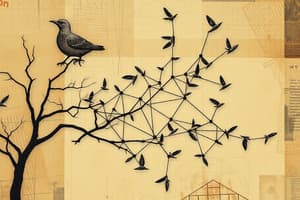Podcast
Questions and Answers
What is a graph in the context of data structures?
What is a graph in the context of data structures?
- A hierarchical data structure with a single root node
- A data structure with a fixed number of edges
- A type of tree with only two nodes
- A finite set of nodes with edges between nodes (correct)
What is the primary difference between a tree and a graph?
What is the primary difference between a tree and a graph?
- Graphs have a single root node, while trees do not
- Trees are a special case of graphs with no loops (correct)
- Graphs are always connected, while trees are not
- Trees are used in social networks, while graphs are used in maps
What is a key characteristic of the edges in a tree?
What is a key characteristic of the edges in a tree?
- Each node can have any number of edges
- There are always n-1 edges in a tree with n nodes (correct)
- There is always a single edge between each node
- Edges are always directed in a tree
What type of relationship exists between nodes in a tree?
What type of relationship exists between nodes in a tree?
What is a common application of graphs?
What is a common application of graphs?
What is a key feature of a graph that distinguishes it from a tree?
What is a key feature of a graph that distinguishes it from a tree?
What does each relationship in a graph represent?
What does each relationship in a graph represent?
What is an individual data element of a graph called?
What is an individual data element of a graph called?
What is a weighted edge?
What is a weighted edge?
What is a self-loop?
What is a self-loop?
What is a connected graph?
What is a connected graph?
What is the indegree of a node?
What is the indegree of a node?
Flashcards are hidden until you start studying
Study Notes
Definition and Basics of Graphs
- A graph is a non-linear data structure consisting of a finite set of nodes with edges between them.
- A graph G can be formally represented as (V, E), where V is a finite set of nodes, and E is a set of pairs of nodes.
Graph vs. Tree
- A tree is a connected graph with no loops or cycles.
- Graphs can have cycles and disconnected components, while trees are connected with no cycles.
- In a tree, each node (except the root) has exactly one parent, whereas in a graph, nodes can have multiple parents or no parents.
Node and Edge Relationships
- Nodes (or vertices) represent entities such as people, cities, computers, words, etc.
- Edges (x, y) represent relationships between entities x and y, such as distance, friendship, child-parent relationships, etc.
Graph Terminology
- A vertex (or node) is an individual data element of a graph.
- An edge is a connecting link between two vertices and can be undirected, directed, or weighted.
- Undirected edges are bidirectional, while directed edges are unidirectional.
- Weighted edges have a cost or value associated with them.
Edge Types and Graph Properties
- Parallel edges or multiple edges have the same endpoints.
- A self-loop is an edge that connects a node to itself.
- A simple graph has no parallel or self-loop edges.
- Adjacent nodes are connected by an edge.
- A path is a sequence of vertices that connect two nodes in a graph.
Graph Connectivity
- An undirected graph is connected if there is a path between every pair of nodes.
- A disconnected graph is one where there is no path between some pair of nodes.
Indegree and Graph Types
- The indegree of a node is the number of edges incident to it.
- Types of graphs include undirected, directed, complete, and weighted graphs.
Studying That Suits You
Use AI to generate personalized quizzes and flashcards to suit your learning preferences.




